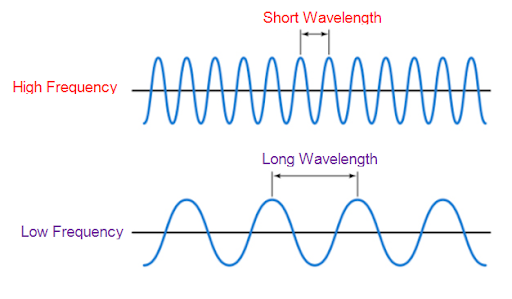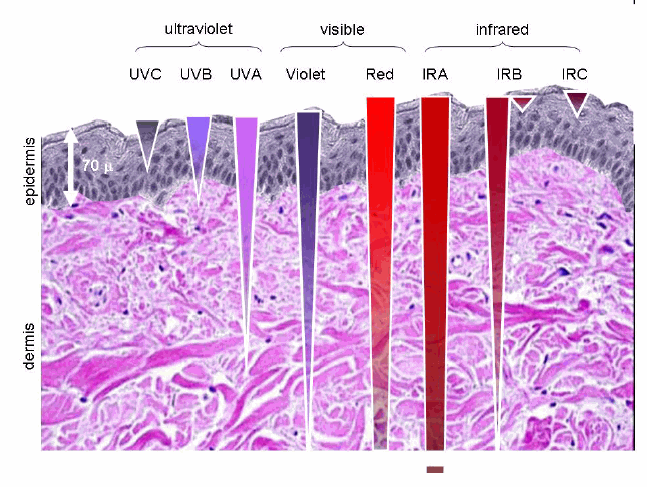Red light therapy is a hot new topic. So many beginners ask about the science. “What does red light therapy do?” is the common first question. You’ve come to the right place if you are curious, but don’t want to pore through technical details.
In this article, we take a deeper look at photobiomodulation (PBM). PBM is the science of how light affects living tissue.

What is Light?
Electromagnetism is the physics involving radiation. In other words, the science of how charged fundamental particles move through space. Charged electrons travel in harmonious waves of energy called “photons”. The patterns travelled by these photons can vary. (Think of various types of waves you’ve encountered in your life, whether at the ocean or listening to an echo in a large empty space.)
Portions of the electromagnetic spectrum, in particular the upper end of the visible light light spectrum and just above (red and near-infrared light), have been studied by researchers and physicians for the effect that they have on the cells of living creatures. In particular, scientists have discovered that specific waves of light affect mitochondria, which are components of a living cell.
Photobiomodulation: How Light Affects Living Cells
Different kinds of light can affect different kinds of cells in different ways. Scientists and the medical research community have studied these effects for many years now. Scientists are studying new treatments and applications all the time. We are learning so much about how light affects cells. But the science isn’t that simple. You can’t just shine a flashlight at your body and expect it to change. And while we know generally that it is healthier for most people to spend a reasonable time outside in the sunlight rather than indoors all day and all night, it’s a bit more complicated than that. Light comes in many different forms.
The Job of a Cell
Cells can have many “jobs” in the body. These jobs include metabolic regulation, immune signaling, programmed cell death, and many other functions. Since certain types of cells “do certain things”, such as fight infection, reproduce, and repair tissue, all living cells require energy to perform these tasks. It takes the right kind of photon to stimulate the production of ATP within the mitochondria.
Frequencies & Wavelengths are How Light Is Measured
As your exploration of the potential benefits of red light therapy continues, you will encounter terms like “nanometers” and “wavelengths” and “frequency”.
The terms “frequency” and “wavelength” are measurements of these different types of waves. The two terms are related.
Frequency refers to the time required for waves to oscillate, or “cycle”. For example, a 60 hertz wave completes 60 oscillations per second. Wavelength refers to the distance between the two of the same points along a wave’s cycle. Since any given wave always travels at a constant rate, the distance between the nearest two peaks and the nearest two troughs will always be identical.

Most devices measure the light administered as a wavelength, and since a wavelength is a distance, it will usually be measured in nanometers, abbreviated as “nm”. One nanometer is equivalent to 0.0000001 centimeters. Pretty short!
Why are Wavelengths Important in Light Therapy?
Wavelength is one of the primary determinants of how deep into living tissue the light will penetrate. This is important because, for example, treating an area deep in the brain requires a different wavelength of light than a wrinkle on the surface of the skin.
Why is Red Light Good, but Other Colors are Not?
Here is where we get to put all of the pieces of the science together. Shorter wavelengths of light (colors like green, blue, and ultraviolet) do not penetrate tissue. But red and near infrared do penetrate human tissue. As a result, red is “the” color for light therapy. For this reason, shorter wavelengths of light get reflected by tissue, while very long wavelengths of light transfer the light (kind of like “passing-through”). Human tissue absorbs the red portion of the spectrum.
The benefits of light on human health has been studied for decades. And we all know that plants need visible light from the sun to grow and life to thrive. But some of the interest in the practical application of red and near-infrared light came from NASA, who used the light to grow plants on the Space Shuttle and also found that it helped to heal wounds.
Is the Science Settled? Does Light Really Make a Difference for Health and Medical Issues?
We feel very strongly that there’s really no such thing as “settled science”. Here at Red Light Therapy 101, we will always view findings with an open mind and a critical eye. We think that there are always more questions to ask. There is always room for more research. And we believe that new things will always be discovered if we continue to ask objective, rational questions and seek truth.
So the most appropriate answer is that every consumer should find all of the facts that they can, share those facts with other truth-seekers, and only take prudent measures with your own health, informed by the facts that you have gathered. Our advice is to understand the potential benefits and risks of all possible treatments. Consult a range of experts and gather their recommendations. And then make an informed decision about which treatments to pursue, understanding that there’s no such thing as a “sure thing” and “zero risk”.
That’s why we created the Red Light Therapy 101 Facebook group. All interested consumers are invited to join the group, learn from each other, share their own experiences. If you haven’t joined the group yet, please join soon and be there for the discussions.
